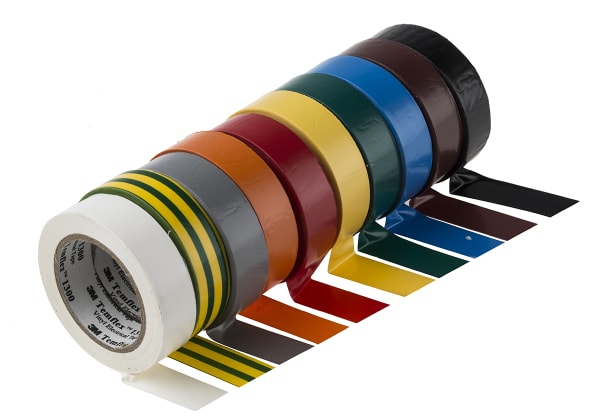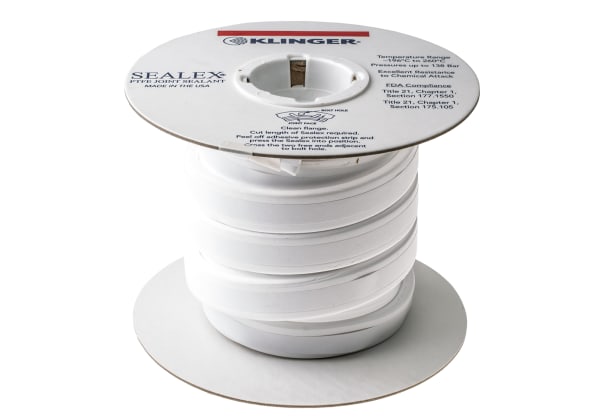- Published Feb 10, 2023
- Last Modified Aug 29, 2023
- 12 min
Gaffer Tape Buying Guide
Discover the uses of gaffer tape and find out how to choose the right type of gaffer tape for your requirements.

What is Gaffer Tape?
Gaffer tape (sometimes referred to as gaffa, gaffer’s, or simply gaff tape) is a widely used, superior quality form of removable adhesive tape.
Several unique factors contribute to the enduring popularity of gaffer tape as a leading adhesive product. Generally speaking, it is prized by professionals and hobbyists alike as a good value adhesive product with a reputation for performing extremely reliably across a broad array of demanding, heavy-duty applications.
In this comprehensive guide, we will look more closely at some of the main strengths of gaffer tape compared to some other common tape varieties. We’ll also identify some of the most suitable tasks and environments for usage, discuss exactly which varieties are available for handling specific types of jobs, and find out more about how and where to buy gaffer tape online.
What is Gaffer Tape Used for?
One of the most familiar gaffer tape uses is temporarily holding down and securing cables to walls or floors. Gaffer tape used on wiring runs generally serves a dual purpose, both reducing the visibility of trailing cables, and helping to minimise the risk of hazardous tripping or snagging.
Because this is a particularly frequent requirement in the entertainment industry, gaffer tape is often primarily associated with technician roles. Indeed, the job of chief lighting technician is widely referred to as a ‘gaffer’, most notably among film crews. While it’s not entirely clear whether this is necessarily where the name ‘gaffer’s tape’ initially derived from, it’s certainly true that the two terms remain closely linked. To this day, cables that have been fixed down in such a manner are commonly said to have been ‘gaffed’ or ‘gaffered’.
Therefore, it should come as no surprise that you’re likely to find this sort of tape in near-constant use around nearly every film and TV set, music stage, rehearsal or performance space - and in pretty much any other environment where electrical cabling needs to be fixed firmly and safely in place for a limited time then removed later on. Certain brands might be labelled specifically as ‘theatre gaffer’s tape’ or ‘photography gaffer tape’, but in essence, the chances are that they’re largely suitable for a wide range of purposes (provided you choose a suitable width, length, colour etc for the task at hand).
However, it should be noted that ‘sticking down wires’ isn’t the only answer to the question ‘what is gaffer tape used for?’ In fact, this versatile tape is regularly put to all kinds of diverse uses, in all manner of challenging environments. The unique strengths of gaffer tape over many other temporary adhesive materials make it an ideal choice for short-term fixes across an impressive range of applications and materials.
What are the Different Types of Gaffer Tape?
There are various different types of gaffer tape available to buy, each best suited to differing applications. If you’re looking to make a purchase but are still asking yourself ‘what type of gaffer tape should I buy?’ then it always helps to know the specifics of each type.
Here are some of the different types of gaffa tape:
Cloth Gaffer Tape
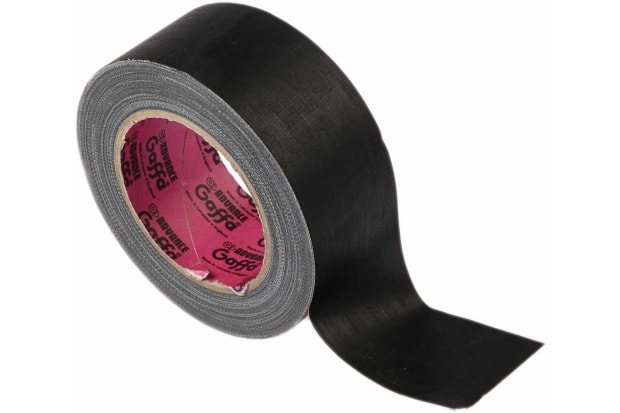
Almost all gaffer tapes are actually cloth-based. In fact, a heavy-duty cloth backing material is a fundamental aspect of what defines a product as true gaffer tape, as opposed to one of the many other industrial tape varieties (duct tapes, for example). While it’s not uncommon to hear people refer to ‘gaffer’s cloth tape’ or similar, it’s generally understood that all such products will, in fact, be constructed from a robust fabric material, with a high-quality adhesive backing on one side. Standard gaffer tape is almost always a variety of cloth tape. It’s typically made from a rugged, tight-woven fabric webbing, which is then coated with various synthetic materials and compounds in order to enhance its overall durability. For more information on materials and manufacturing processes, see the FAQs at the end of this guide.
Matt Gaffer Tape
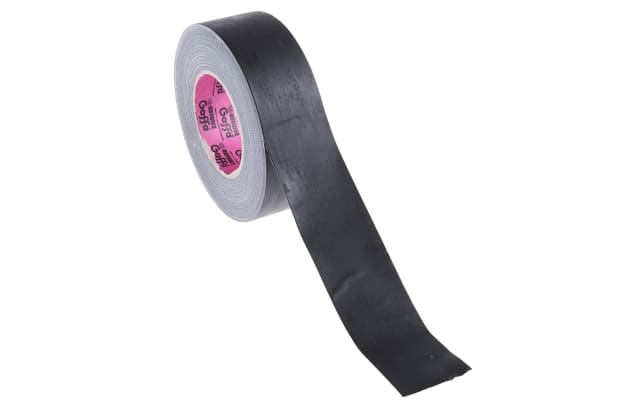
Matte or matt gaffer tape is one of the most effective varieties when it comes to disguising unsightly cabling and wire runs that you don’t want to be easily visible from a distance. This is often one of the main reasons why matte gaffa tape is usually preferred in applications such as film and stage work. The fact that most gaffer tape doesn’t reflect light very well when coated with a duller surface texture means that it is hidden from view more effectively. Matte black gaffer’s tapes are especially useful in darkened environments, where nearby lighting setups might otherwise reflect off the surface of shinier products and thus be more obvious to onlookers.
Gloss Gaffer Tape
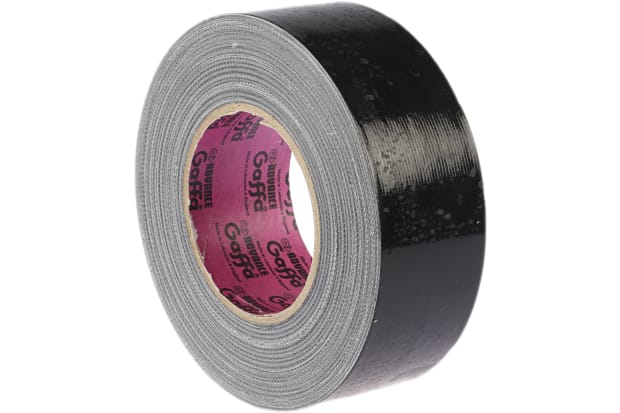
Although gaffer tape matte finishes are usually the more popular varieties, gloss gaffa tape is also available. This tends to be used when the opposite effect is required, i.e. when it’s helpful to have the precise location of any secured cables or other components highlighted. This is typically done for safety reasons, especially in locations where reduced light and visibility is more of a potential hazard than an aesthetic bonus. Indeed, various types of reflective or even fluorescent gaffer tape are also available for a more highly pronounced highlighting effect in similar scenarios.
Coloured Gaffer Tape
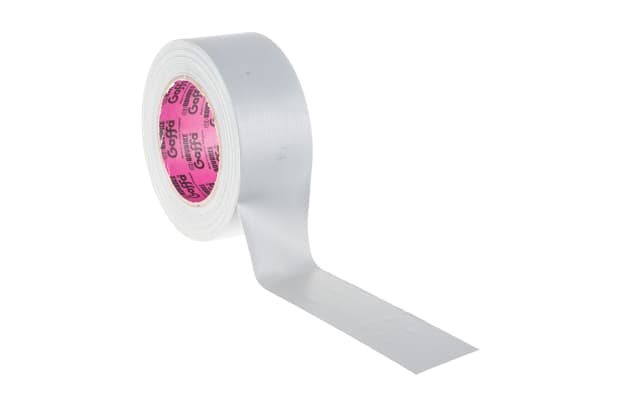
Coloured gaffer tape is another widely available alternative which can come in handy for numerous reasons. In particular, many buyers may prefer to opt for a specific colour of gaffa tape in order to blend it into its surroundings more easily. For example, brown gaffer tape might be a better option for hiding cables on a wooden stage, while green, blue or red gaffa tape will make a popular choice for many types of sporting or other outdoor events. Different coloured tape can also be used in situations where it’s helpful to differentiate between multiple stuck-down cables, components or other items. Additionally, it can be used for quick-reference adhesive labelling and identification purposes. While coloured options are generally less popular than standard white or black gaffer tape, a few examples of alternative colours you may come across include silver, yellow, green, red, and brown. Lighter colour choices make it easy to write on the tape with a variety of standard pens. Clear gaffer tape is also a good option in some situations, especially when it’s important to be able to identify a specific component or wire quickly.
Waterproof Gaffer Tape
Is gaffer tape waterproof? This is a commonly asked question when it comes to gaffer tape, yet the answer isn’t always clear. However, the reality is that most gaffer’s tape is ‘water-resistant’ rather than entirely waterproof. Being cloth-based, it’s not completely immune to the effects of water and dampness in the immediate environment - this includes rain, spillages, and potentially even high humidity levels.
While the majority of gaffer tapes are coated with various compounds that help to boost performance in the presence of moisture, there are generally better choices out there if protecting against wetness is your primary objective when choosing an adhesive tape product.
Different Types of Gaffer Tape
The following content clearly illustrates the benefits and main uses of some of the different types of gaffer tape:
Coloured Gaffer Tape
Benefits :
- Great for various specialist applications
- Ideal for easy identification purposes
- Lighter shades allow for easy marking or labelling
Applications :
- Colour coding wires and cables
- Stage prop spiking
- Safety marking in industrial settings
Waterproof Gaffer Tape
Benefits :
- Designed for temporary adhesion
- Matt versions prevent light reflection
Applications :
- Suitable for moist or humid environments
Clear Gaffer Tape
Benefits :
- Flexible and conformable
- Ideal for discreet applications
Applications :
- Ideal for splicing fabrics and carpets where joining
Gloss Gaffer Tape
Benefits :
- Excellent durability
- Flexible and easy to use
Applications :
- Well suited to a wide range of applications including domestic, industrial, and signage
Matt Gaffer Tape
Benefits :
- Ideal for areas of low light reflection
- Possibility to label the surface of the tape
Applications :
- Ideal for use in the entertainment industries including film and TV and photography
Heavy Duty Gaffer Tape
Benefits :
- Highly suitable for sealing, wrapping and repair
- Greater flexibility than alternative types of tape
Applications :
- Ideal for industrial applications
See the final section of this guide for more FAQs and general tips on choosing the best gaffer tape for a specific application.
How to Choose the Right Gaffer Tape
Understanding which type of gaffer tape you should buy really comes down to the particular applications and environments that you will be using it in. Simply put, knowing how to choose gaffer tape just means knowing what you’ll be doing with it!
With that said, we’ve outlined a few considerations that you might want to bear in mind when picking out the ideal gaffa tape for your specific needs:
Gaffer Tape by Length
25m gaffer tape and 50m gaffer tape rolls are typical lengths, but it’s easy to cut a length from the roll to match the required size when you come to use it.
One big advantage of gaffer tape is that its high-quality adhesive won’t cure or dry out easily. This means that any unused tape should remain useable for an extended period of time, as long as you are storing it in the correct conditions.
Gaffer Tape by Backing Material
As previously mentioned, nearly all varieties of gaffer tape are made from fabric and cloth. However, it is worth noting that certain products - generally those designed for very specific tasks and install environments - may introduce different materials to the standard cloth-based format, while still being called gaffer tape.
One notable example is foil gaffer tape, which is backed with a thin, flexible, yet robust metallic sheet, as opposed to cloth gaffer tape. This type is generally intended for use in much more extreme temperature ranges than standard gaffa tape. Like other somewhat niche cases, this sort of product is very much the exception to the general gaffa tape rule, but it can still prove to be a handy option when a specific situation calls for it.
Comparing Gaffer Tape to Other Tapes
When looking to compare gaffer tape to other widely used heavy-duty tape products, the most common variety singled out for side-by-side comparison is duct tape. The two tapes often look quite similar at first glance, and they are frequently considered for use in similar sorts of environments. In fact, though, they’re quite different products, and each has its own particular pros and cons in specific applications.
Gaffer Tape vs. Duct Tape
The comparison of duct tape vs gaffer tape can be quite an important one. The main difference between duct tape and gaffer tape is in their construction and material composition, as explained below:
Gaffer Tape
- As we’ve already highlighted, gaffer tape is primarily cloth-based, meaning it incorporates a tough, tight-woven fabric mesh as its main structural material
- This will then be augmented and enhanced with various additional compounds and coatings, depending on the specific variant of gaffer tape
- In addition, gaffer tape tends to be backed with a much higher-quality synthetic rubber adhesive
Duct Tape
- By contrast, duct tape is generally a cheaper and less robust product
- Being plastic or vinyl-based, duct tape prioritises water-resistance over structural robustness and doesn’t perform as well as gaffa when subject to mechanical stresses or warmer temperatures
- Duct tape also typically uses a less advanced, more aggressive adhesive. It sticks very well to an extremely wide range of surfaces, but it will usually leave a far messier residue behind when removed and can damage some surfaces in the process
So, next time you hear someone asking, ‘is gaffer tape duct tape?’, you can tell them exactly why the answer is a definitive ‘no’!
FAQs
Does Gaffer Tape Leave Residue?
Gaffer tape typically leaves very little residue - and indeed is much less prone to doing so than duct tape - thanks in part to its construction. Being cloth-based and backed with a higher-quality, less aggressive adhesive, gaffer tape generally has less impact on most surfaces and is more resistant to the bonding effects of heat. Besides the core materials used, the relative lack of sticky adhesive residue left behind after removing gaffer tape is often cited as one of its key advantages over duct tape.
Does Gaffer Tape Stick to Fabric/Carpet?
Yes, it does. Like most tapes, gaffer is generally somewhat easier to remove from fabrics than from hard surfaces, and therefore probably isn’t an ideal solution for any particularly demanding or critical applications. However, it will adhere firmly to carpets, rugs, towelling, cloth mats, furs and other fibre-based surfaces, and is a good choice if you’re just looking to hold down a couple of cables for a while. Also, as noted above, gaffer tape won’t leave behind a lot of messy adhesive residue when you remove it from fabric - although be aware that it can lift some more delicate fibres away with it on removal.
Does Gaffer Tape Stick to Brick?
Yes. If using on natural uncoated brick, you will achieve far better purchase overall if you clean off as much dust and dirt from the surface as possible first. On painted brick, gaffer tape will usually stick very effectively.
Is Gaffer Tape Electrical Tape?
No. While gaffer is predominantly used for securing and holding down cables and wiring runs, it does not provide very effective electrical insulation - this is the key role of true electrical tape, which is generally plastic-based (most often vinyl). Since fabric-based gaffer tape can potentially conduct electricity under the right circumstances, it’s not a wise choice for wrapping, coating or otherwise insulating/protecting bare electrical wires.
Is Gaffer Tape Heat Resistant?
Being made largely from cloth, gaffer tape is relatively heat resistant for a product in this category (certainly more so than many plastic-based alternatives, such as duct tape). However, even gaffer can only hold its own within a fairly limited temperature range; exceeding this will eventually cause it to melt, and possibly even catch fire. Very few widely available tape products are entirely heat resistant, so if protecting against extremes of temperature is your main objective, then adhesive tape of any variety is unlikely to be the right tool for the job.
How is Gaffer Tape Made?
Like all tapes, gaffer tape is made on very large factory rolls. First, the base material - a sort of heavy cloth weave, coated with various other strengthening substances - is unwound from a single large roll, passing through a machine that applies a hot adhesive mix (along with a solvent-based compound to prevent unwanted curing) to one side. Once the sticky side of the gaffer tape has thus been created, the tape is re-rolled back onto a single large reel, before a further machine slices it down into multiple rolls at various standard retail widths.
How Long Does Gaffer Tape Last?
Over a long enough timeframe, all adhesive tape will eventually lose its stickiness - this happens because the various adhesive compounds and solvents used on one side of the tape will eventually evaporate or begin to cure after extended periods of exposure to air and UV radiation (i.e. daylight). However, gaffer retains its adhesive properties for a lot longer than many other products in its category, largely thanks to the denser weave of its fabric backing material.
Various environmental and physical factors will affect how long gaffer tape stays in good, robust condition for. The most important of these will be any repeated mechanical stresses put on the tape once it’s in place, and the type of environment it’s exposed to (e.g. heat, moisture, dust/dirt ingress). On the whole, you can expect gaffer tape to last very well compared to most other temporary adhesive products.
